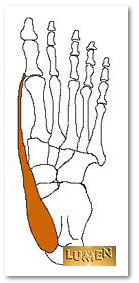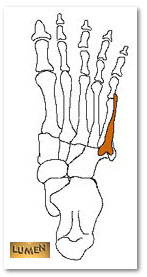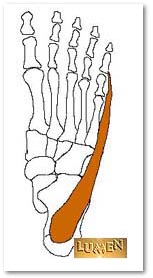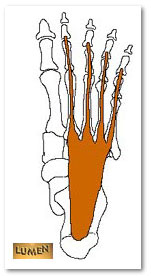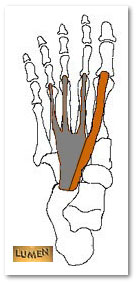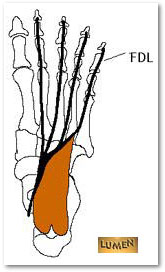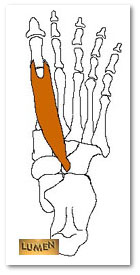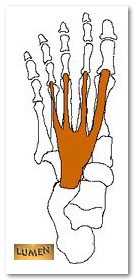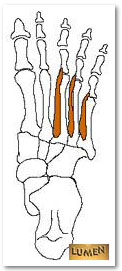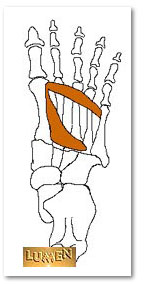The Ultimate Foot Muscles Anatomy Trivia Quiz!
(152).jpg)
Ever wondered how much do you know about the foot muscles anatomy? Do you know what major muscles extend the foot? Do you know what muscles are in the bottom of the foot? Check out our online quiz and see if you can name the various foot muscles and score 100% in the quiz.
- 1.
Name this muscle ?
- A.
ABDUCTOR DIGITI MINIMI
- B.
FLEXOR DIGIT MINIMI
- C.
ABDUCTOR DIGIT V
- D.
ADDUCTOR HALLUCIS
- E.
ABDUCTOR HALLUCIS
Correct Answer
E. ABDUCTOR HALLUCISExplanation
The correct answer is ABDUCTOR HALLUCIS. The abductor hallucis muscle is located in the foot and is responsible for the abduction of the big toe, which means it moves the toe away from the midline of the foot. It helps to maintain balance and stability while walking or standing.Rate this question:
-
- 2.
Name this muscle
- A.
FLEXOR DIGITORUM BREVIS
- B.
FLEXOR DIGITI MINIMI
- C.
ABDUCTOR HALLUCIS
- D.
ABDUCTOR DIGITI V
- E.
FLEXOR HALLUCIS BREVIS
Correct Answer
B. FLEXOR DIGITI MINIMIExplanation
The correct answer is FLEXOR DIGITI MINIMI. This muscle is responsible for flexing the little toe.Rate this question:
-
- 3.
Name this muscle
- A.
ABDUCTOR HALLUCCIS
- B.
FLEXOR DIGITORUM BREVIS
- C.
LUMBRICALS
- D.
ABDUCTOR DIGITI V
- E.
FLEXOR ACCESSORIUS
Correct Answer
D. ABDUCTOR DIGITI VExplanation
The correct answer is ABDUCTOR DIGITI V. This muscle is responsible for the abduction (movement away from the midline) of the fifth digit (little toe). It helps in spreading the toes apart and maintaining balance during walking or running.Rate this question:
-
- 4.
Name this muscle
- A.
ADDUCTOR HALLUCIS
- B.
FLEXOR DIDGITORUM BREVIS
- C.
ABDUCTIOR HALLUCIS
- D.
ABDUCTOR DIGIT V
- E.
FLEXOR ACCESSORIUS
Correct Answer
B. FLEXOR DIDGITORUM BREVISExplanation
The correct answer is FLEXOR DIDGITORUM BREVIS. This muscle is located in the foot and is responsible for flexing the toes. It helps in gripping the ground while walking or running.Rate this question:
-
- 5.
Name this muscle
- A.
EXTENSOR HALLUCIS
- B.
EXTENSOR DIGIORUM BREVIS
- C.
ADDUCTOR HULLUCIS
- D.
ABDUCTOR HALLUCIS
Correct Answer
A. EXTENSOR HALLUCISExplanation
The correct answer is EXTENSOR HALLUCIS. This muscle is responsible for extending the big toe, allowing it to move away from the body. It is located on the front of the lower leg and plays a crucial role in maintaining balance and stability while walking or running.Rate this question:
-
- 6.
Name this muscle
- A.
PLANTAR INTEROSSEI
- B.
QUADRATUS PLANTAE
- C.
LUMBRICALS
- D.
FLEXOR ACCESSORIUS
- E.
BOTH B AND D
Correct Answer
E. BOTH B AND DExplanation
The correct answer is BOTH B AND D. The muscle referred to in the question is responsible for flexing the toes and assisting in plantar flexion. Both the Quadratus Plantae and the Flexor Accessorius muscles are involved in these actions. Therefore, the correct answer is both B and D.Rate this question:
-
- 7.
Name this muscle
- A.
FLEXOR DIGITI MINIMI
- B.
ADDUCTOR HALLUCIS
- C.
ABDUCTOR HALLUCIS
- D.
FLEXOR HALLUCIS BREVIS
Correct Answer
D. FLEXOR HALLUCIS BREVISExplanation
The correct answer is Flexor Hallucis Brevis. This muscle is located in the foot and is responsible for flexing the big toe. Its name, "hallucis," refers to the big toe, and "brevis" means short, indicating that this muscle is a short flexor of the big toe.Rate this question:
-
- 8.
Name this muscle
- A.
FLEXOR DIGITORUMM BREVIS
- B.
EXTENSOR DIGITORUM BREVIS
- C.
LUMBRICALS
- D.
ADDUCTOR HALLUCIS
Correct Answer
B. EXTENSOR DIGITORUM BREVISExplanation
The correct answer is EXTENSOR DIGITORUM BREVIS. The extensor digitorum brevis is a muscle located in the foot. It is responsible for extending the toes and assisting in dorsiflexion of the foot. This muscle helps to lift the toes off the ground and aids in maintaining balance while walking or running.Rate this question:
-
- 9.
Name this muscle
- A.
DORSAL INTEROSSEI
- B.
PLANTAR INTEROSSEI
- C.
EXTENSION HALLUCIS BREVIS
- D.
EXTENSOR DIGIORUM BREVIS
- E.
FLEXOR DIGITORUM BREVIS
Correct Answer
B. PLANTAR INTEROSSEIExplanation
The correct answer is PLANTAR INTEROSSEI. The plantar interossei muscles are located in the foot and are responsible for flexing the toes at the metatarsophalangeal joints. They also assist in stabilizing the foot during walking and running.Rate this question:
-
- 10.
Name this muscle
- A.
ADDUCTOR HALLUCIS
- B.
ABDUCTOR HALLUCIS
- C.
FLEXOR HALLUCIS BREVIS
- D.
FLEXOR DIGITI MINIMI
- E.
LUMBRICALS
Correct Answer
A. ADDUCTOR HALLUCISExplanation
The correct answer is ADDUCTOR HALLUCIS. The adductor hallucis muscle is located in the foot and is responsible for adducting the big toe towards the midline of the foot. This muscle helps to stabilize the foot during walking and running, and also assists in maintaining balance.Rate this question:
-
- 11.
Insertion point of flexor digit minimi
- A.
Medial side of base of proximal phalanx of hallux
- B.
Base of proximal phalanx of lesser toes
- C.
Lateral side of base of metatarsal head
- D.
Lateral side of base of the 5th proximal phalanx
- E.
Lateral side of the base of the proximal phalanx of hallux
Correct Answer
D. Lateral side of base of the 5th proximal pHalanx -
- 12.
Origins of abductor hallucis
- A.
Medial process of posterior calcaneal tuberosity
- B.
Medial and lateral process of posterior calcaneal tuberosity
- C.
Lateral head of calcaneus tuberosity
- D.
Base of metatarsals
- E.
Plantar surface of the cuboid
Correct Answer
A. Medial process of posterior calcaneal tuberosityExplanation
The abductor hallucis muscle originates from the medial process of the posterior calcaneal tuberosity. This means that it starts from the inner side of the back part of the heel bone.Rate this question:
-
- 13.
Action of flexor digit minimi
- A.
Abduction of 5th metatarophalangeal joint, Support lateral longitudinal arch
- B.
Plantarflexion of 5th metatarsophalangeal joint
- C.
Plantarflexion of metatarophalangeal joints of 4 lesser toes
- D.
Flexes and abducts big toe. Supports medial longitudinal arch
- E.
Abduction of 1st metatarsophalangeal joint
Correct Answer
B. Plantarflexion of 5th metatarsopHalangeal jointExplanation
The action of plantarflexion of the 5th metatarsophalangeal joint refers to the movement of pointing the toes downward or towards the sole of the foot. This action is important for activities such as pushing off the ground during walking or running. It helps to generate power and propulsion during these movements.Rate this question:
-
- 14.
Insertion point of abductor hallucis
- A.
Four lateral toes at border of middle phalanx
- B.
Proximal phalanx of toes 2,3,4,
- C.
Proximal phalanx of hallux
- D.
Medial side of base of proximal phalanx of hallux
- E.
Lateral side of 5th proximal phalanx
Correct Answer
D. Medial side of base of proximal pHalanx of halluxExplanation
The insertion point of the abductor hallucis muscle is located on the medial side of the base of the proximal phalanx of the hallux. This means that the muscle attaches to the inner side of the base of the big toe's first bone.Rate this question:
-
- 15.
Action of abductor hallucis
- A.
Abduction of 5th metatarsophalangeal joint, Support lateral longitudinal arch
- B.
Abduction of 1st metatarsophangeal joint Supports medial longitudinal arch
- C.
Plantarflexion of metatarsophalangeal joint of hallux
- D.
Plantarflexion of metatarsophangeal joint of four lesser toes
- E.
Adduction of 1st metatarsophalangeal joint
Correct Answer
B. Abduction of 1st metatarsopHangeal joint Supports medial longitudinal archExplanation
The action of the abductor hallucis muscle is to abduct the 1st metatarsophalangeal joint. This means that it moves the big toe away from the midline of the foot. This action helps to support the medial longitudinal arch of the foot, which is the arch on the inside of the foot.Rate this question:
-
- 16.
Origins of abductor digit v
- A.
Medial process of posterior calcaneal tuberosity
- B.
Lateral head - tuberosity of calcaneus and medial head - medial side of calcaneus
- C.
Base of the 5th metatarsal
- D.
Medial and lateral processes of posterior calcaneal tuberosity
- E.
Bases of 2,3,4 metatarsals
Correct Answer
D. Medial and lateral processes of posterior calcaneal tuberosityExplanation
The correct answer is "Medial and lateral processes of posterior calcaneal tuberosity." This is because the abductor digiti minimi muscle originates from both the medial and lateral processes of the posterior calcaneal tuberosity. The other options listed, such as the base of the 5th metatarsal and the bases of the 2nd, 3rd, and 4th metatarsals, are not the origins of the abductor digiti minimi muscle.Rate this question:
-
- 17.
Insertion point of abductor digit v
- A.
Lateral side of base of 5th proximal phalanx
- B.
Medial side of base of proximal phalanx of hallux
- C.
Medial side the base of the 5th proximal phalanx
- D.
Lateral side of the base of the proximal phalanx of the hallux
- E.
Proximal phalanx of hallux
Correct Answer
A. Lateral side of base of 5th proximal pHalanxExplanation
The correct answer is "Lateral side of base of 5th proximal phalanx". This is because the abductor digit V muscle is located on the lateral side of the base of the 5th proximal phalanx. The abductor digit V muscle is responsible for the abduction of the little toe, and its insertion point is specifically on the lateral side of the base of the 5th proximal phalanx.Rate this question:
-
- 18.
Action of abductor digiti v
- A.
Plantarflexion of metatarsophalangeal joint
- B.
Abduction of 1st metatarsophalangeal joint
- C.
Abduction of 5th metatarsal phalangeal joint. Supports lateral longitudinal arch
- D.
Plantarflexion of 5th metatarsophalangeal joint
- E.
Flexion of 1st metatarsophalangeal joint , support medial longitudinal arch
Correct Answer
C. Abduction of 5th metatarsal pHalangeal joint. Supports lateral longitudinal archExplanation
The action of the abductor digiti v is the abduction of the 5th metatarsal phalangeal joint, which supports the lateral longitudinal arch. This means that the muscle is responsible for moving the 5th toe away from the midline of the foot, helping to maintain the arch on the outer side of the foot. This action is important for maintaining balance and stability while walking or running.Rate this question:
-
- 19.
Which muscles are in the 1st layer
- A.
FLEXOR DIGITORUM BREVIS
- B.
ABDUCTOR HALLUCIS
- C.
ADDUCTOR HALLUCIS
- D.
ABDUCTOR DIGIT V
- E.
A, B AND D
Correct Answer
E. A, B AND DExplanation
The correct answer is A, B, and D. The question is asking which muscles are in the 1st layer. The Flexor Digitorum Brevis, Abductor Hallucis, and Abductor Digit V are all muscles that are located in the 1st layer. The Adductor Hallucis is not located in the 1st layer, so it is not included in the correct answer.Rate this question:
-
- 20.
Origin of the flexor digit minimi
- A.
Medial process of posterior calcaneal tuberosity & flexor reticulum
- B.
Medial aspect of base of proximal phalanx of big toe via medial sesamoid
- C.
Medial process of posterior calcaneal tuberosity
- D.
Base of 5th metatarsal
- E.
Plantar surface of the cuboid
Correct Answer
D. Base of 5th metatarsalExplanation
The correct answer is "Base of 5th metatarsal". This is because the flexor digiti minimi muscle originates from the base of the 5th metatarsal bone.Rate this question:
-
- 21.
Insertion of flexor digitorum brevis
- A.
Medial side of base of proximal of hallux
- B.
Lateral side of base of 5th proximal phalanx
- C.
Base of proximal phalanx of four lesser toes
- D.
By 3 tendons into proximal phalanx of toes 2,3,4
- E.
Four tendons to four lateral toes to border of middle phalanx.
Correct Answer
E. Four tendons to four lateral toes to border of middle pHalanx.Explanation
The flexor digitorum brevis muscle inserts into the four lateral toes, specifically into the border of the middle phalanx. This means that the muscle attaches to the middle phalanx of each of the four toes, providing flexion and movement to those toes.Rate this question:
-
- 22.
Action of flexor digitorum brevis
- A.
Abduction of 1st metatarsophalangeal joint
- B.
Adduction of 1st metatarsophalangeal joint
- C.
Plantarflexion of metatarophalangeal joint to 4 lesser toes
- D.
Plantarflexion of 5th metatarsophalangeal joint
- E.
Extends lesser interphalangeal joints and flexes lesser metatarsophalangeal joints
Correct Answer
C. Plantarflexion of metataropHalangeal joint to 4 lesser toesExplanation
The action of the flexor digitorum brevis is to plantarflex the metatarsophalangeal joint to the four lesser toes. This means that when the flexor digitorum brevis contracts, it causes the toes to move downward, or point towards the ground, specifically the four toes that are not the big toe. This action is important for walking and maintaining balance, as it helps to push off the ground and propel the body forward.Rate this question:
-
- 23.
Insertion of lumbricals
- A.
Tendons split to give 2 insertion: lateral side of base of the proximal phalanx and dorsal expansion of 3,4,5
- B.
The tendon split to give 2 insertions : to the base of the proximal phalanx and to the dorsal expanion of 2,3,4,5
- C.
Base of proximal phalanx and dorsal expansion , medial side
- D.
Into tendons of flexor didgitorum longus
- E.
Lateral side of the base of the 5th phalangeal joint
Correct Answer
C. Base of proximal pHalanx and dorsal expansion , medial sideExplanation
The correct answer is "Base of proximal phalanx and dorsal expansion, medial side." This is because the tendons of the lumbrical muscles split to give two insertions: one on the lateral side of the base of the proximal phalanx and another on the dorsal expansion of the 3rd, 4th, and 5th fingers. Therefore, the correct answer is the insertion on the base of the proximal phalanx and the dorsal expansion, specifically on the medial side.Rate this question:
-
- 24.
Origins of flexor accessorius
- A.
Lateral head - tuberosity of calcaneus, medial head - medial side of calcaneus
- B.
Medial process of posterior calcaneal tuberosity
- C.
Lateral side of base of 5th proximal phalanx
- D.
Medial and lateral process of posterior calcaneal tuberosity
- E.
Plantar surface of the cuboid
Correct Answer
A. Lateral head - tuberosity of calcaneus, medial head - medial side of calcaneusExplanation
The origins of the flexor accessorius are the tuberosity of the calcaneus for the lateral head and the medial side of the calcaneus for the medial head.Rate this question:
-
- 25.
Action of flexor hallucis brevis
- A.
Plantarflexion of 1st metatarsal phalangeal joint
- B.
Flexion of 1st metatarsal phalangeal joint
- C.
Adduction of 1st meatarsal phalangeal joint
Correct Answer
B. Flexion of 1st metatarsal pHalangeal jointExplanation
The action of the flexor hallucis brevis is to flex the first metatarsal phalangeal joint. This means that it bends the joint, bringing the big toe closer to the sole of the foot. This action is important for activities such as walking, running, and jumping, as it allows for proper propulsion and push-off during these movements.Rate this question:
-
- 26.
Origins of flexor digitorum brevis
- A.
Medial and lateral processes of posterior calcaneal tuberosity
- B.
Lateral head of tuberosity of calcaneus
- C.
Base of the 5th proximal phalanx
- D.
Medial process of posterior calcaneal tuberosity
- E.
Plantar surface of the cuboid
Correct Answer
D. Medial process of posterior calcaneal tuberosityExplanation
The correct answer is the medial process of the posterior calcaneal tuberosity. This is the origin of the flexor digitorum brevis, a muscle located in the foot. The other options listed are not the origins of this muscle.Rate this question:
-
- 27.
Insertion piont of flexor accessorius
- A.
Base of proximal phalanx and dorsal expansion
- B.
The tendons split to give 2 inserations to base of the proximal phalanx and dorsal expansin of 2,3,4,5
- C.
Lateral side of the base of the 5th proximal phalanx
- D.
Into the tendons of flexor digitorum longus
- E.
The tendons split to give 2 inserations to base of the proximal phalanx and dorsal expansin of 3,4,5
Correct Answer
D. Into the tendons of flexor digitorum longusExplanation
The correct answer is "Into the tendons of flexor digitorum longus." This is because the given information states that the tendons of the flexor accessorius split to give two insertions, one being into the base of the proximal phalanx and dorsal expansion of digits 2, 3, 4, and 5, and the other being into the tendons of the flexor digitorum longus. Therefore, the insertion point of the flexor accessorius is into the tendons of the flexor digitorum longus.Rate this question:
-
- 28.
Action of flexor accessorius
- A.
Extends lesser interphalangeal joint
- B.
Plantar flexion of metatarsophalangeal joint
- C.
Redirection the pull of FDL and assist plantarflexion
- D.
Adduction of 1st metatarsophalangeal joint
- E.
Abduction of 1st metatarsophalangeal joint
Correct Answer
C. Redirection the pull of FDL and assist plantarflexionExplanation
The given correct answer states that the action of flexor accessorius is to redirect the pull of the flexor digitorum longus (FDL) and assist in plantarflexion. This means that the flexor accessorius helps to change the direction of the force exerted by the FDL and aids in the movement of pointing the foot downwards (plantarflexion).Rate this question:
-
- 29.
Which muscle are the sesamoid bone inserted into the tendon
- A.
Flexor digit V
- B.
Abductor Hallucis
- C.
Adductor Hallucis
- D.
Flexor digiti minimi
- E.
Flexor hallucis brevis
Correct Answer
E. Flexor hallucis brevisExplanation
The sesamoid bones are small bones that are embedded within a tendon or joint capsule. In this case, the correct answer is Flexor hallucis brevis. This muscle is located in the foot and is responsible for flexing the big toe. The sesamoid bones are inserted into the tendon of the Flexor hallucis brevis muscle, providing support and protection to the joint.Rate this question:
-
- 30.
Which muscle origin from medial process of posterior calcaneal tuberosity
- A.
Flexor digitorium brevis
- B.
Abductor Hallucis
- C.
Adductor Hallucis
- D.
Plantar interossei
- E.
Both A and B
Correct Answer
E. Both A and BExplanation
Both the flexor digitorum brevis and the abductor hallucis muscles originate from the medial process of the posterior calcaneal tuberosity.Rate this question:
-
- 31.
Origins of lumbricals
- A.
2nd from medial aspect of 1st tendon of FDL, 1,3,4 from adjacent of FDL
- B.
4th from medial aspect of 4th tendon of FDL, 1,2,3,from adjacent of FDL
- C.
1st from medial aspect of 1st tendon of FDL, 2,3,4 from adjacent of FDL
- D.
Joint capsules & inter metatarsal ligments of 2,3,4
- E.
Joint capsuls & intermetatarsal ligaments of 3,4,5
Correct Answer
C. 1st from medial aspect of 1st tendon of FDL, 2,3,4 from adjacent of FDLExplanation
The lumbricals originate from the tendons of the flexor digitorum longus (FDL) muscle. The 1st lumbrical originates from the medial aspect of the 1st tendon of FDL, while the 2nd, 3rd, and 4th lumbricals originate from the adjacent tendons of FDL. This means that the 1st lumbrical originates from the specific tendon of FDL, while the other three lumbricals originate from the tendons next to it.Rate this question:
-
- 32.
Name a unipennate muscle
- A.
Flexor accessorius
- B.
Adductor hallucis
- C.
Lumbrical
Correct Answer
C. LumbricalExplanation
A lumbrical is a type of unipennate muscle. Unipennate muscles are characterized by their fibers attaching to one side of a central tendon, resembling a feather. The lumbrical muscles are found in the hand and foot, connecting the tendons of the flexor digitorum profundus to the extensor hoods. They play a role in flexing the metacarpophalangeal joints and extending the interphalangeal joints.Rate this question:
-
- 33.
Insertion of flexor hallucis brevis
- A.
The tendons of FDL
- B.
Lateral side of the base of the 5th proximal phalanx
- C.
Lateral side of the base of proximal phalanx of hallux
- D.
The tendons split to give 2 insertions to either side of the base of the proximal phalanx
Correct Answer
D. The tendons split to give 2 insertions to either side of the base of the proximal pHalanxExplanation
The tendons of the flexor hallucis brevis split into two insertions, one on either side of the base of the proximal phalanx. This means that the tendon divides into two branches, each of which attaches to a different side of the bone. This allows for better control and coordination of movement in the hallux (big toe), as the tendons can exert force on both sides of the bone.Rate this question:
-
- 34.
Origins of adductor hallucis
- A.
Transverse head : joint capsul & intermetatarsal ligaments of 3,4,5 oblique head: base of 2,3,4 metatarsals
- B.
Transverse head : joint capsul & intermetatarsal ligaments of 2,4,5 oblique head: base of 2,3,4 metatarsals
- C.
Transverse head : joint capsul & intermetatarsal ligaments of 3,4,5 oblique head: base of 3,4,5 metatarsals
- D.
Transverse head : joint capsul & intermetatarsal ligaments of 2,3,4,5 oblique head: base of 2,3,4, 5 metatarsals
Correct Answer
A. Transverse head : joint capsul & intermetatarsal ligaments of 3,4,5 oblique head: base of 2,3,4 metatarsalsExplanation
The correct answer states that the origins of the adductor hallucis are the joint capsule and intermetatarsal ligaments of the 3rd, 4th, and 5th metatarsals for the transverse head, and the base of the 2nd, 3rd, and 4th metatarsals for the oblique head. This means that the transverse head of the adductor hallucis muscle originates from the joint capsule and ligaments between the 3rd, 4th, and 5th metatarsals, while the oblique head originates from the base of the 2nd, 3rd, and 4th metatarsals.Rate this question:
-
- 35.
Action of adductor hallucis
- A.
Abduction of 1st metatarsal phalangeal joint
- B.
Abduction of 5th metatarsal phalangeal joint
- C.
Adduction of 1st metatarsal phalangeal joint
- D.
Adduction of 5th metatarsal phalangeal joint
Correct Answer
C. Adduction of 1st metatarsal pHalangeal jointExplanation
The correct answer is adduction of 1st metatarsal phalangeal joint. The adductor hallucis is a muscle that is responsible for adducting the big toe towards the midline of the foot. This action occurs at the 1st metatarsal phalangeal joint, which is the joint between the base of the big toe and the first metatarsal bone. Therefore, the action of the adductor hallucis is adduction of the 1st metatarsal phalangeal joint.Rate this question:
-
- 36.
Origins of flexor hallucis brevis
- A.
Plantar surface of the cuboid
- B.
Base of 5th metatarsal
- C.
Base of 2,3,4 metatarsals
- D.
Plantar surface of calcaneal
- E.
Lateral head of posterior calcaneal
Correct Answer
A. Plantar surface of the cuboidExplanation
The flexor hallucis brevis muscle originates from the plantar surface of the cuboid bone.Rate this question:
-
- 37.
Which muscle insert into lateral side of the base of the proximal phalanx of the hallux
- A.
Adductor hallucis
- B.
Abductor hallucis
- C.
Flexor hallucis brevis
- D.
Both a and c
- E.
Both b and c
Correct Answer
D. Both a and cExplanation
Both the adductor hallucis and the flexor hallucis brevis muscles insert into the lateral side of the base of the proximal phalanx of the hallux. The adductor hallucis muscle helps to adduct or bring the hallux towards the midline of the foot, while the flexor hallucis brevis muscle flexes the hallux or bends it downwards. Therefore, both of these muscles contribute to the movement and stability of the hallux. The abductor hallucis muscle, on the other hand, inserts into the medial side of the base of the proximal phalanx of the hallux, so it is not involved in this specific insertion site.Rate this question:
-
- 38.
Origins of plantar interossei
- A.
Bipennate from inner aspects of shafts of all metatarsals
- B.
Inferomedial shafts of 3rd , 4th and 5th metatarsals
- C.
Adjacent sides of 3,4.5 metatarsal shafts
- D.
Medial side of 2, 3, 4
- E.
Adjacent sides of 2,3,4
Correct Answer
C. Adjacent sides of 3,4.5 metatarsal shaftsExplanation
The correct answer is "Adjacent sides of 3,4.5 metatarsal shafts." This means that the plantar interossei muscles originate from the adjacent sides of the shafts of the 3rd and 4th metatarsals, as well as from the shaft of the 5th metatarsal. This indicates the specific location from where these muscles arise.Rate this question:
-
- 39.
Insertion point of plantar interossei
- A.
Bases of proximal phalanges and dorsal extensor expansions of medial side of 2nd toe and lateral sides of 2nd , 3rd and 4th toes
- B.
The tendons split to give 2 insertions to lateral side of base of the proximal phalanx and dorsal expansion of 3, 4. 5
- C.
The tendons split to give 2 insertions to lateral side of base of the proximal phalanx and dorsal expansion of 2, 3, 4. 5
- D.
Medial sides of bases of proximal phalanges with slips to dorsal extensor expansions of 3rd, 4th and 5th toes
- E.
The tendons split to give 2 insertions to lateral side of base of the proximal phalanx and dorsal expansion of 2, 3, 4.
Correct Answer
B. The tendons split to give 2 insertions to lateral side of base of the proximal pHalanx and dorsal expansion of 3, 4. 5Explanation
The correct answer is the only option that mentions the tendons splitting to give two insertions to the lateral side of the base of the proximal phalanx and dorsal expansion of the 3rd, 4th, and 5th toes. This indicates that the insertion point of the plantar interossei is on the lateral side of the base of the proximal phalanx and extends to the dorsal expansion of the 3rd, 4th, and 5th toes. The other options either mention different toes or do not mention the dorsal expansion of the 5th toe, making them incorrect.Rate this question:
-
- 40.
ORIGINS OF DORSAL INTEROSSEI
- A.
Medial side of 2nd and adjacent sides of 2nd,3rd,4th,and 5th meatatarsal shafts
- B.
Bases of proximal phalanges and dorsal extensor expansions of medial side of 2nd toe and lateral sides of 2nd , 3rd and 4th toes
- C.
Medial side of 2nd and adjacent sides of 3rd,4th,and 5th meatatarsal shafts
- D.
Bases of proximal phalanges and dorsal extensor expansions of medial side of 2nd toe and lateral sides of 2nd , 3rd 4th and 5th toes
Correct Answer
A. Medial side of 2nd and adjacent sides of 2nd,3rd,4th,and 5th meatatarsal shaftsExplanation
The correct answer is the medial side of the 2nd and adjacent sides of the 2nd, 3rd, 4th, and 5th metatarsal shafts. This is because the dorsal interossei muscles originate from these specific locations.Rate this question:
-
- 41.
Insertion of dorsal interossei
- A.
Bases of proximal phalanges and dorsal extensor expansions of medial side of 2nd toe and lateral sides of 2nd , 3rd and 4th toes
- B.
Bases of proximal phalanges and dorsal extensor expansions of medial side of 3rd toe and lateral sides of 2nd , 3rd and 4th toes
- C.
Bases of proximal phalanges and dorsal extensor expansions of medial side of 2nd toe and lateral sides of 3rd and 4th toes
- D.
Bases of proximal phalanges and dorsal extensor expansions of medial side of 2nd toe and lateral sides of 3rd, 4th and 5th toes
Correct Answer
A. Bases of proximal pHalanges and dorsal extensor expansions of medial side of 2nd toe and lateral sides of 2nd , 3rd and 4th toesExplanation
The correct answer is the insertion of dorsal interossei. The dorsal interossei muscles originate from the bases of the proximal phalanges and the dorsal extensor expansions of the medial side of the 2nd toe and the lateral sides of the 2nd, 3rd, and 4th toes. These muscles are responsible for abduction and flexion of the toes, and they play a role in maintaining balance and stability during walking and running.Rate this question:
-
- 42.
Action of dorsal interossei
- A.
Abduction of 2nd , 3rd and 4th toes, flexion of interphalangeal joints and metatarsal phalangeal joints
- B.
Adduction of 2nd , 3rd and 4th toes, flexion of interphalangeal joints and metatarsal phalangeal joints
- C.
Abduction of 3rd,4th and 5th toes, flexion of interphalangeal joints and metatarsal phalangeal joints
- D.
Adduction of 3rd,4th and 5th toes, flexion of interphalangeal joints and metatarsal phalangeal joints
Correct Answer
A. Abduction of 2nd , 3rd and 4th toes, flexion of interpHalangeal joints and metatarsal pHalangeal jointsExplanation
The action of the dorsal interossei muscles is to abduct the 2nd, 3rd, and 4th toes. Additionally, these muscles contribute to the flexion of the interphalangeal joints and metatarsophalangeal joints.Rate this question:
-
- 43.
Attachments of long plantar ligaments
- A.
Distally: deep part of navicular, superfical part to base of 2,3,4 metatarsals
- B.
Distally: deep part of cubiod, superfical part to base of 2,3,4 metatarsals
- C.
Proximally: plantar surface of calcaneum distal to tubercles
- D.
Both a and c
- E.
Both b and c
Correct Answer
E. Both b and cExplanation
The correct answer is both b and c. The attachments of the long plantar ligaments include the deep part of the cuboid and the superficial part to the base of the 2nd, 3rd, and 4th metatarsals (distally). Additionally, the ligaments attach to the plantar surface of the calcaneum distal to the tubercles (proximally). Therefore, both options b and c are correct as they include the correct attachments of the long plantar ligaments.Rate this question:
-
- 44.
Insertion of extensor digiorum brevis
- A.
By 2 tendons into proximal phalanx of 2, 3,
- B.
By 2 tendons into proximal phalanx of 3, 4,
- C.
By 3 tendons into proximal phalanx of 2, 3, 4
- D.
By 3 tendons into proximal phalanx of 3, 4, 5
Correct Answer
C. By 3 tendons into proximal pHalanx of 2, 3, 4Explanation
The correct answer is "by 3 tendons into proximal phalanx of 2, 3, 4". This means that the extensor digitorum brevis muscle inserts into the proximal phalanx of the second, third, and fourth digits (fingers or toes) using three tendons. This information provides a specific and accurate description of the insertion point of the muscle.Rate this question:
-
- 45.
Action of extensor digiorum brevis
- A.
Extends 2, 3,4 metatarsal phalangeal joints
- B.
Extends 3,4,5 metatarsal phalangeal joints
- C.
Extends 3,4 metatarsal phalangeal joints
- D.
Extends 2, 3 metatarsal phalangeal joints
Correct Answer
A. Extends 2, 3,4 metatarsal pHalangeal jointsExplanation
The action of the extensor digitorum brevis muscle is to extend the 2nd, 3rd, and 4th metatarsophalangeal joints.Rate this question:
-
- 46.
Insertion of extensor hallucis brevis
- A.
Medial phalanx of hallux
- B.
Lateral base of 5th proximal phalanx
- C.
Proximal phalanx of hallux
- D.
Lateral side of the base of the proximal phalanx
Correct Answer
C. Proximal pHalanx of halluxExplanation
The extensor hallucis brevis muscle is responsible for extending the big toe. It originates from the medial side of the foot and inserts onto the proximal phalanx of the hallux (big toe). Therefore, the correct answer is "proximal phalanx of hallux", as it accurately describes the insertion point of the extensor hallucis brevis muscle.Rate this question:
-
- 47.
Insertion of adductor hallucis
- A.
Lateral side of the base of proximal phalanx of the hallux
- B.
Lateral side of the base of the 5th proximal phalanx
- C.
Medial side of base of proximal phalanx of hallus
- D.
Base of the proximal phalanx
Correct Answer
A. Lateral side of the base of proximal pHalanx of the halluxExplanation
The adductor hallucis muscle inserts on the lateral side of the base of the proximal phalanx of the hallux (big toe). This means that the muscle attaches to the outer side of the base of the big toe's proximal phalanx. It does not insert on the base of the 5th proximal phalanx or the base of the proximal phalanx in general.Rate this question:
-
- 48.
Action of extensor hallucis brevis
- A.
Extends 5th metatarsal phalangeal joint
- B.
Extends all metatarsal joints
- C.
Plantar flexion of 1st metatarsal phalangeal joint
- D.
Extends 1st metatarsal phalangeal joint
Correct Answer
D. Extends 1st metatarsal pHalangeal jointExplanation
The action of the extensor hallucis brevis muscle is to extend the 1st metatarsal phalangeal joint.Rate this question:
-
- 49.
ORIGINS OF EXTENSOR DIGITORUM BREVIS
- A.
Superior surface of calcaneum
- B.
Plantar surface of calcaneum
- C.
Superior surface of cuboid
- D.
Plantar surface of cuboid
Correct Answer
A. Superior surface of calcaneumExplanation
The extensor digitorum brevis muscle originates from the superior surface of the calcaneum bone. This means that it starts from the top surface of the heel bone.Rate this question:
-
- 50.
ORIGINS OF EXTENSOR DIGIORUM BREVIS
- A.
Superior surface of anterior calcaneum
- B.
Plantar surface of calcaneum
- C.
Superior surface of cubiod
- D.
Base of 4th metatarsals
Correct Answer
A. Superior surface of anterior calcaneumExplanation
The extensor digitorum brevis muscle originates from the superior surface of the anterior calcaneum. This means that it starts from the top surface of the front part of the heel bone.Rate this question:
-
Quiz Review Timeline +
Our quizzes are rigorously reviewed, monitored and continuously updated by our expert board to maintain accuracy, relevance, and timeliness.
-
Current Version
-
Aug 14, 2024Quiz Edited by
ProProfs Editorial Team -
Jan 05, 2010Quiz Created by
Littletough
- Aura Quizzes
- Axial Skeleton Quizzes
- Body Mechanics Quizzes
- Body Parts Quizzes
- Body System Quizzes
- Chest Quizzes
- Ear Quizzes
- Endocrine Quizzes
- Eye Quizzes
- Feet Quizzes
- Gland Quizzes
- Limb Quizzes
- Musculoskeletal Quizzes
- Pain Quizzes
- Pharmacodynamics Quizzes
- Piercing Quizzes
- Spanish Body Parts Quizzes
- Thorax Quizzes
- Urine Quizzes
 Back to top
Back to top



